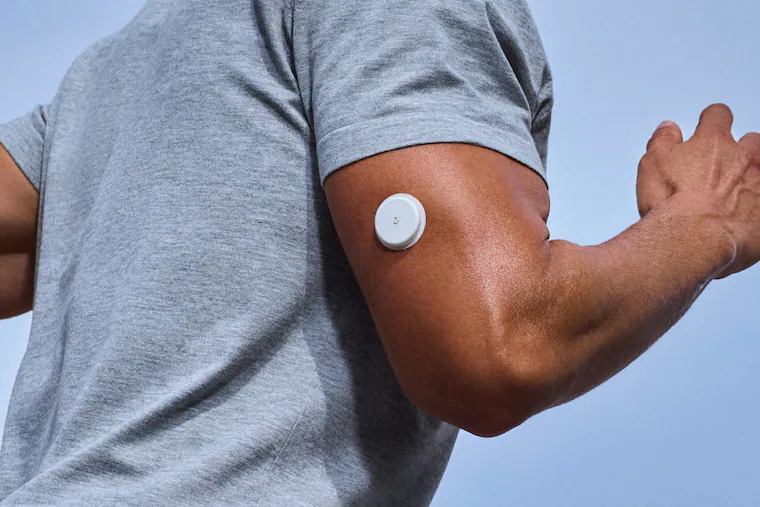
Robert F. Kennedy Jr. has promised “bold, decisive action” to reform our food and health. So far, though, most of his plans involve subtraction. As secretary of health and human services, he has taken away funding for research, access to vaccines, and many, many scientists’ jobs.
Meanwhile, he’s suggested precious few additions. But one of them is wearable technology in the form of continuous glucose monitors (CGMs), an example of the kind of devices that Kennedy claims can enable people to “make good judgments about their diet, about their physical activity, about the way that they live their lives.”
CGMs are part of a push for “personalized nutrition,” an approach that tailors dietary recommendations to the individual, taking into account genetic profile, microbiome analysis, and other biometrics in addition to readings from a monitor.
Can the devices make a real dent in obesity and disease?
In a word, *sigh.*
CGMs don’t actually measure blood sugar; they measure sugar in the fluid between your cells, just under your skin, which is very similar to the amount in your blood. And they exist because they’re very useful if you have diabetes, or you’re at high risk. Nobody (that I’ve seen) disputes their value there. The question is whether they can be useful for people who don’t have diabetes but are trying to eat better or lose weight, or both.
To find out, I spoke with Kevin Hall, recently of the National Institutes of Health. You may know him as the co-author of what is arguably the most influential study on ultra-processed foods. (It found that people ate 500 calories more per day when food was ultra-processed.) His new book, Food Intelligence, co-written with journalist Julia Belluz, looks long and hard at personalized nutrition, and CGMs in particular.
The theory behind personalized nutrition, as Hall and Belluz point out in the book, is that one-size-fits-all advice — Eat whole grains and vegetables! Cut back on sugar and saturated fat! — fails to improve public health because humans vary tremendously, and one size simply doesn’t fit all.
So Belluz set out to get personalized advice. She tested out CGMs, and several of the apps that use the data (along with data gathered from blood, stool, and some other tests) to make dietary recommendations. The chapter where Hall and Belluz look at these results is one of the most interesting in the book; the recommendations were all over the map.
This should surprise no one familiar with CGM readings, because they, too, are all over the map. Partly, that’s because monitors are not super accurate. Readings from different CGMs differ, and you even can even get different readings from your right and left arm. But readings also differ because glucose responses are widely variable.
“People have different responses to the same meal on different days,” Hall told me. “In fact, the variability in people’s responses to the same meal can be as wide as their responses to different meals. How can you make a glucose-lowering recommendation with data like that?”
And the responses to individual foods vary depending on other factors as well, such as stress, sleep, and physical activity. And then there’s the context of the meal — or exercise. Belluz noticed, for example, that going for a run elicited a blood sugar spike, but eating cake after a meal didn’t. (Full disclosure: I’ve known Belluz for years and am a longtime fan of her work.)
But there’s a more fundamental problem with CGMs as a health intervention. For people without diabetes, the body generally will keep blood sugar within the normal, nondiabetic range no matter what you eat.
“When you give these devices to a lot of people, something like 94% of the time people are within the normal glucose range,” Hall said. Focusing on controlling blood sugar spikes can help people with high blood glucose levels better manage blood sugar, but other benefits are hard to find.
Showing that an intensive, personalized diet and lifestyle intervention has benefits over standardized advice should be child’s play. If I get a highly prescriptive diet, support from professionals, and regular check-ins, I’m probably going to have more success than if I get a brochure, standard diet advice, and less personal attention.
Even so, when the people behind Zoe, one of the apps that incorporates CGM data (among other metrics), designed a study to test its product against standard advice, the results were not overwhelming. The Zoe group lost less than 5 pounds in 18 weeks, compared with a control group that was basically flat. Other changes, including insulin and glucose, were small and mostly insignificant.
Another study, funded by DayTwo, a personalized nutrition company that also uses blood glucose data paired with other measurements, found improvements in glycemic control on its personalized diet but no weight-loss advantage versus the Mediterranean diet.
A trial funded by the American Heart Association found that a personalized diet based on glucose response wasn’t any better than standard low-fat diet advice for weight loss over six months; both groups lost less than 10 pounds.
Weight loss isn’t the only issue, of course, and if CGM readings help people cut out refined carbohydrates, that’s probably a dietary win. But it’s hard to tell whether CGMs improve dietary quality because we have to rely on self-reported information. If the changes we can measure (such as insulin and glucose) are small, it’s reasonable to assume that things we can’t measure, like diet quality, also haven’t changed much.
Hall acknowledges that, despite the variability of measurement, CGMs can be helpful to people trying to limit carbohydrates. “It will show you if you’re on track,” he said, “but it’s not because of your unique biology. It’s just a reliable way to show if you’re eating a lot of refined carbs.” But, he warned, there’s also a danger that a CGM can make things worse. “If you’re optimizing for one thing, what about the things you’re not? Can they be going in the wrong direction? Some people on low-carb diets experience an alarming rise in LDL cholesterol. It could be a blind spot.”
If there were a continuous low-density lipoprotein monitor, I’d be writing a different column.
The appeal of CGMs as a fix for lousy diets and weight problems is the same as the appeal of every other fix that has come down the line and failed to make a dent in the problem. People love the idea that if they just do This One Thing, they’ll right the ship. The fact that it didn’t work out with fat, or with gluten, or with meat, or with sugar, doesn’t seem to faze CGM advocates. This time they have it right.
The human body is an astonishingly complex machine, with moving parts everywhere you look. Most of those parts, we don’t fully understand. Some we don’t even know about. Humans are hard to study, and progress on understanding the machine is slow and uncertain. The idea that any one lever is the key to a healthful diet is remarkably implausible.
Standard-issue dietary advice doesn’t fail because it’s one-size-fits-all. It fails because people can’t follow it in a food environment that surrounds us with calorie-dense, nutrition-challenged, cheap, convenient food specifically designed to be overeaten. Hall asked me to picture “a single mother of four kids with two jobs and obesity” up against that environment. “Sending her a CGM in the mail, I can’t imagine how that will meaningfully affect her.”
“All this precision nutrition stuff is interesting,” he said. “But to think that this is a public health solution, in the context of our food environment, is delusional.”



